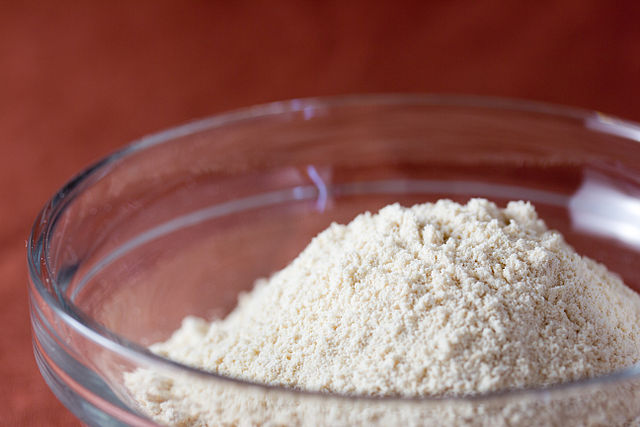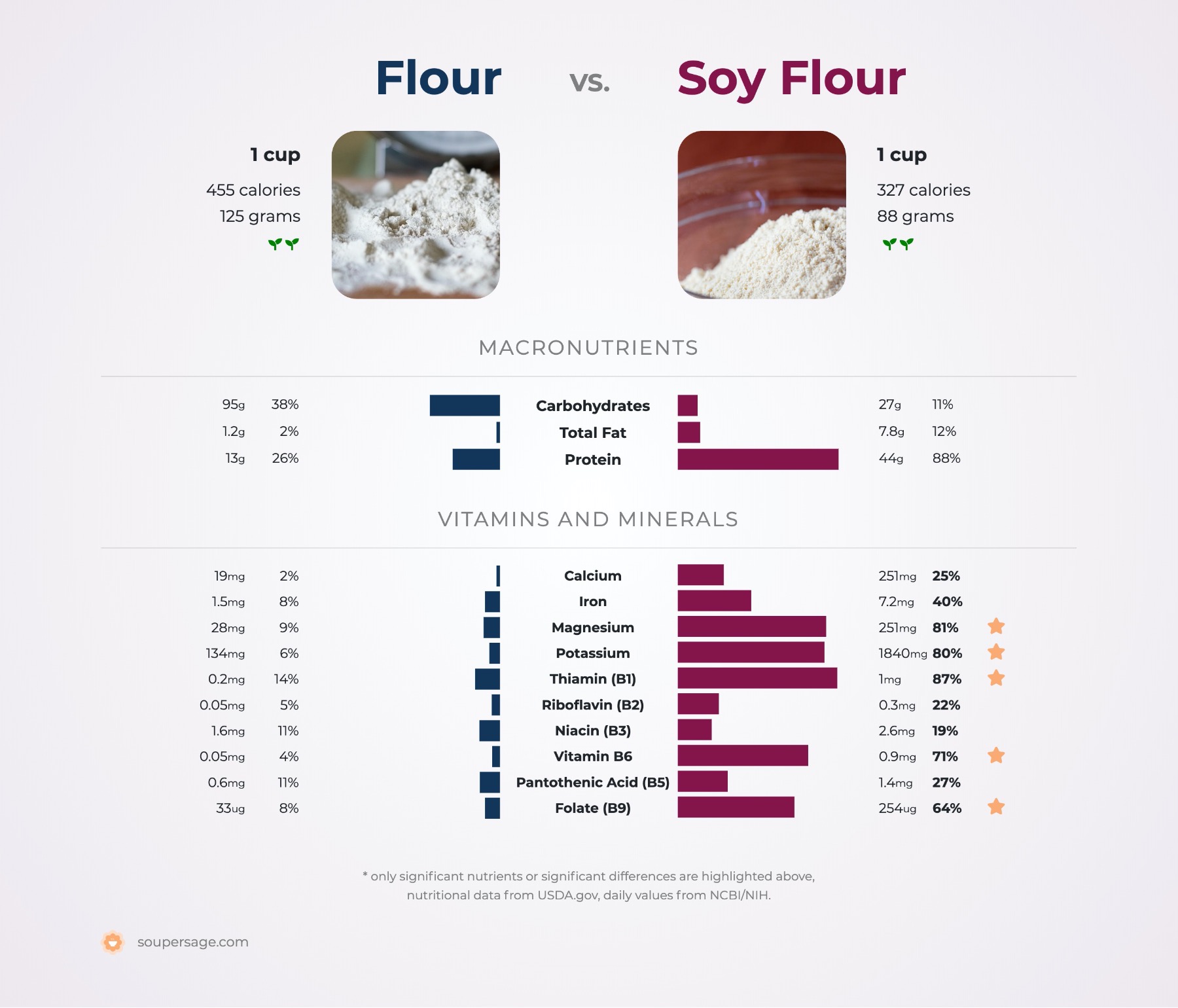Flour vs. Soy Flour
Nutrition comparison of Flour and Soy Flour
Ever wonder how your favorite foods stack up against each other in terms of nutrition?
We compared the nutritional contents of
flour
versus
soy flour
(100g each)
below using 2020 USDA and NIH data[1].
For a quick recap of significant nutrients and differences in flour and soy flour:
- Both flour and soy flour are high in calories, carbohydrates, dietary fiber and protein.
- Flour has 33.5 times less sugar than soy flour.
- Flour has 7.3 times less saturated fat than soy flour.
- Soy flour has more thiamin, riboflavin, niacin, pantothenic acid, Vitamin B6 and folate.
- Soy flour is an excellent source of calcium, iron and potassium.
USDA sources for nutritional information: Flour (Wheat flour, white, all-purpose, unenriched) and Soy Flour (Soy flour, low-fat) . Have a correction or suggestions? Shoot us an email.
Calories and Carbs
calories
Both flour and soy flour are high in calories. Flour is very similar to flour for calories - flour has 364 calories per 100 grams and soy flour has 372 calories.
For macronutrient ratios, flour is much lighter in protein, much heavier in carbs and lighter in fat compared to soy flour per calorie. Flour has a macronutrient ratio of 12:86:2 and for soy flour, 50:31:20 for protein, carbohydrates and fat from calories.
Macro Ratios from Calories:
| Flour | Soy Flour | |
|---|---|---|
| Protein | 12% | 50% |
| Carbohydrates | 86% | 31% |
| Fat | 2% | 20% |
| Alcohol | ~ | ~ |
carbohydrates
Both flour and soy flour are high in carbohydrates. Flour has 149% more carbohydrates than soy flour - flour has 76.3g of total carbs per 100 grams and soy flour has 30.6g of carbohydrates.
dietary fiber
Both flour and soy flour are high in dietary fiber. Soy flour has 493% more dietary fiber than flour - flour has 2.7g of dietary fiber per 100 grams and soy flour has 16g of dietary fiber.
sugar
Flour has 33.5 times less sugar than soy flour - flour has 0.27g of sugar per 100 grams and soy flour has 9.3g of sugar.
Protein
protein
Both flour and soy flour are high in protein. Soy flour has 382% more protein than flour - flour has 10.3g of protein per 100 grams and soy flour has 49.8g of protein.
Fat
saturated fat
Flour has 7.3 times less saturated fat than soy flour - flour has 0.16g of saturated fat per 100 grams and soy flour has 1.3g of saturated fat.
Vitamins
Vitamin A
Soy flour and flour contain similar amounts of Vitamin A - soy flour has 2ug of Vitamin A per 100 grams and flour does not contain significant amounts.
Vitamin E
Flour and soy flour contain similar amounts of Vitamin E - flour has 0.06mg of Vitamin E per 100 grams and soy flour has 0.55mg of Vitamin E.
Vitamin K
Flour and soy flour contain similar amounts of Vitamin K - flour has 0.3ug of Vitamin K per 100 grams and soy flour has 3.9ug of Vitamin K.
The B Vitamins
Soy flour has more thiamin, riboflavin, niacin, pantothenic acid, Vitamin B6 and folate.
| Flour | Soy Flour | |
|---|---|---|
| Thiamin | 0.12 MG | 1.088 MG |
| Riboflavin | 0.04 MG | 0.28 MG |
| Niacin | 1.25 MG | 2.95 MG |
| Pantothenic acid | 0.438 MG | 1.55 MG |
| Vitamin B6 | 0.044 MG | 1.05 MG |
| Folate | 26 UG | 289 UG |
Minerals
calcium
Soy flour is an excellent source of calcium and it has 18 times more calcium than flour - flour has 15mg of calcium per 100 grams and soy flour has 285mg of calcium.
iron
Soy flour is an excellent source of iron and it has 601% more iron than flour - flour has 1.2mg of iron per 100 grams and soy flour has 8.2mg of iron.
potassium
Soy flour is an excellent source of potassium and it has 18 times more potassium than flour - flour has 107mg of potassium per 100 grams and soy flour has 2090mg of potassium.
Antioxidants and Phytonutrients
Omega-3 and Omega-6
omega 3s
For omega-3 fatty acids, soy flour has more alpha linoleic acid (ALA) than flour per 100 grams.
| Flour | Soy Flour | |
|---|---|---|
| alpha linoleic acid | 0.022 G | 0.555 G |
| Total | 0.022 G | 0.555 G |
omega 6s
Comparing omega-6 fatty acids, soy flour has more linoleic acid than flour per 100 grams.
| Flour | Soy Flour | |
|---|---|---|
| linoleic acid | 0.391 G | 3.66 G |
| other omega 6 | ~ | 0.025 G |
| Total | 0.391 G | 3.685 G |
Customize your serving size
The comparison below is by common portions, e.g. cups, packages. You can also see a more concrete comparison by weight at equal weight (by grams) comparison.
Flour g
()
|
Daily Values (%) |
Soy Flour g
()
|
|||||
|---|---|---|---|---|---|---|---|
| KCAL % |
|
5% | calories | 5% |
|
KCAL % | |
| G % |
|
5% | carbohydrates | 5% |
|
G % | |
| G % |
|
5% | dietary fiber | 5% |
|
G % | |
| G | 5% | sugar | 5% | G | |||
| G % |
|
5% | total fat | 5% |
|
G % | |
| G % |
|
5% | saturated fat | 5% |
|
G % | |
| G | 5% | monounsaturated fat | 5% | G | |||
| G | 5% | polyunsaturated fat | 5% | G | |||
| G | 5% | trans fat | 5% | G | |||
| MG | 5% | cholesterol | 5% | MG | |||
| MG % |
|
5% | sodium | 5% |
|
MG % | |
| 5% | Vitamins and Minerals | 5% | |||||
| UG % |
|
5% | Vitamin A | 5% |
|
UG % | |
| MG % |
|
5% | Vitamin C | 5% |
|
MG % | |
| IU % |
|
5% | Vitamin D | 5% |
|
IU % | |
| MG % |
|
5% | calcium | 5% |
|
MG % | |
| MG % |
|
5% | iron | 5% |
|
MG % | |
| MG % |
|
5% | magnesium | 5% |
|
MG % | |
| MG % |
|
5% | potassium | 5% |
|
MG % | |
| MG % |
|
5% | thiamin (Vit B1) | 5% |
|
MG % | |
| MG % |
|
5% | riboflavin (Vit B2) | 5% |
|
MG % | |
| MG % |
|
5% | niacin (Vit B3) | 5% |
|
MG % | |
| MG % |
|
5% | Vitamin B6 | 5% |
|
MG % | |
| MG % |
|
5% | pantothenic acid (Vit B5) | 5% |
|
MG % | |
| UG % |
|
5% | folate (Vit B9) | 5% |
|
UG % | |
| UG % |
|
5% | Vitamin B12 | 5% |
|
UG % | |
| MG % |
|
5% | Vitamin E | 5% |
|
MG % | |
| UG % |
|
5% | Vitamin K | 5% |
|
UG % | |
| G % |
|
5% | protein | 5% |
|
G % | |
| UG % |
|
5% | biotin (Vit B7) | 5% |
|
UG % | |
| MG % |
|
5% | choline | 5% |
|
MG % | |
| MG % |
|
5% | chlorine | 5% |
|
MG % | |
| UG % |
|
5% | chromium | 5% |
|
UG % | |
| MG % |
|
5% | copper | 5% |
|
MG % | |
| UG % |
|
5% | fluoride | 5% |
|
UG % | |
| UG % |
|
5% | iodine | 5% |
|
UG % | |
| MG % |
|
5% | manganese | 5% |
|
MG % | |
| UG % |
|
5% | molybdenum | 5% |
|
UG % | |
| MG % |
|
5% | phosphorus | 5% |
|
MG % | |
| UG % |
|
5% | selenium | 5% |
|
UG % | |
| MG % |
|
5% | zinc | 5% |
|
MG % | |
| G | 5% | Water | 5% | G | |||
| G | 5% | Starch | 5% | G | |||
| G | 5% | Alcohol | 5% | G | |||
FAQ
Does flour or soy flour contain more calories in 100 grams?Both flour and soy flour are high in calories. Flour is quite similar to flour for calories - flour has 364 calories in 100g and soy flour has 372 calories.
Is flour or soy flour better for protein?
Both flour and soy flour are high in protein. Soy flour has 380% more protein than flour - flour has 10.3g of protein per 100 grams and soy flour has 49.8g of protein.
Does flour or soy flour have more carbohydrates?
By weight, both flour and soy flour are high in carbohydrates. flour has 150% more carbohydrates than soy flour - flour has 76.3g of carbs for 100g and soy flour has 30.6g of carbohydrates.
Does flour or soy flour contain more calcium?
Soy flour is a rich source of calcium and it has 18 times more calcium than flour - flour has 15mg of calcium in 100 grams and soy flour has 285mg of calcium.
Does flour or soy flour contain more iron?
Soy flour is an abundant source of iron and it has 600% more iron than flour - flour has 1.2mg of iron in 100 grams and soy flour has 8.2mg of iron.
Does flour or soy flour contain more potassium?
Soy flour is a rich source of potassium and it has 18 times more potassium than flour - flour has 107mg of potassium in 100 grams and soy flour has 2090mg of potassium.


